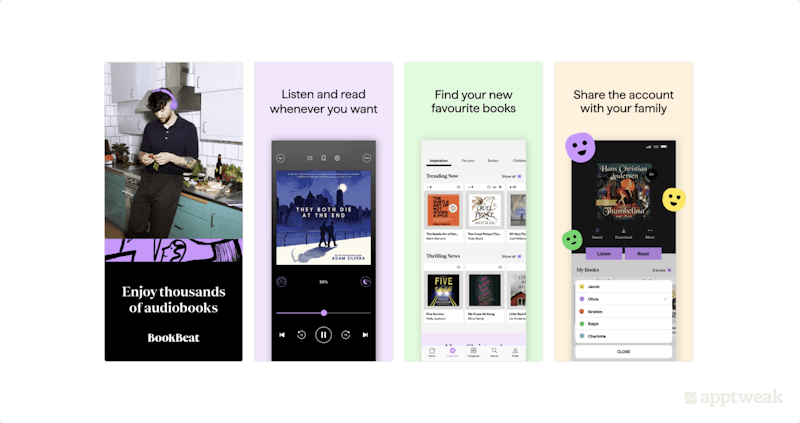
앱으로 트래픽을 유도하는 10가지 방법
앱으로 트래픽을 유도하는 것은 앱 스토어 내 우리 앱이 생존하기 위해 필수 과정입니다.
특정 시장에서 유저의 요구에 대응하는 유용한 앱을 만들더라도 잠재 유저가 앱을 발견할 수 있는 적절한 마케팅 전략을 활용하지 못하면 이러한 노력이 손실될 수 있습니다.
App Store 및 Google Play에서 앱 또는 게임의 트래픽을 더 많이 얻으면 가시성, 다운로드, 유저 참여 측면에서 수를 증가할 수 있으며, 궁극적으로 앱 리뷰 및 평점의 개선 효과를 얻을 수 있습니다.
이 블로그에서는 앱 스토어에서 앱 또는 게임의 트래픽을 늘리는 데 도움이 되는 10가지 가장 방법을 상세히 알아보겠습니다.
1. ASO 전략 모니터링 및 개선
애플에 따르면, 앱 다운로드의 65%는 검색 결과에서 나온다고 합니다.
결과적으로 앱 스토어 최적화(ASO) 관점에서 최적화된 앱은 검색 결과에 노출이 되고 니즈가 충족되는 잠재 유저에게 도달 될 가능성이 높습니다.
ASO는 앱이 스토어의 검색 결과에서 더 높은 순위를 차지하고 앱과 관련성이 높은 잠재 유저에게 다가갈 수 있도록 도와줍니다.
브랜드 검색으로 인해 단어당 다운로드 수가 증가하는 경우도 있지만, 일반 키워드 검색을 통해 카테고리 내 경쟁 앱보다 높은 가시성을 통해 앱에 추가적인 다운로드를 가져오는 경우가 더 많습니다.
다음은 ASO 전략을 개선하는 데 도움이 되는 몇 가지 팁입니다:
- 앱의 목적을 설명하고 유저가 기억하기 쉬운 올바른 앱 이름을 선택합니다. 앱 이름과 함께 앱이 특정 타겟 키워드의 순위에 오를 수 있는 관련성이 높은 일반 키워드를 제목에 추가합니다.
- 앱에 가장 관련성이 높은 카테고리를 선택합니다. 앱에 관련된 카테고리가 두 개 이상 있을 수 있습니다. 카테고리 변동성 및 순위에 오를 키워드와 같은 요소를 고려해야 합니다.
- 데이터로 백업되는 키워드 감사를 실행하여 앱에 가장 관련성이 높고 트래픽이 많은 키워드를 찾습니다. 유저들이 검색하는 인기 검색 키워드를 추출하여 잠재력이 높은 키워드를 최적화합니다.
- 크리에이티브 자산을 최적화합니다. 앱의 고유한 판매 제안을 설명하는 정성적이고 창의적인 스크린샷의 우선순위를 지정합니다. 앱의 최고 기능을 보여주고 배경과 잘 대조되는 짧은 문장과 잘 보이는 텍스트를 선택합니다.


- 앱 스토어 목록을 현지화합니다. 여러 국가에서 앱을 사용할 수 있는 경우 앱 메타데이터와 시각 자료를 현지 시장의 언어와 문화에 맞게 조정해야 합니다. 앱 스토어 현지화는 단순히 텍스트를 번역하는 것을 넘어 검색 행동, 모바일 선호도 및 전 세계 경쟁 환경에 영향을 미칠 수 있는 시장 간 문화적 차이를 분석하는 것이 중요합니다.


- 정기적으로 앱을 업데이트하고 모니터링합니다. ASO는 한번의 작업으로 끝내는 것이 아닌 지속적인 과정임을 인지합니다. 정기적으로 새 기능으로 앱을 업데이트하고 버그를 수정하며 개선 사항을 구현해야 합니다. 이것은 앱이 최적의 유저 경험을 제공하고 잘 유지된다는 것을 유저에게 보여주는데 도움이 됩니다.
2. 앱의 랜딩 페이지를 최상의 방법으로 표시
웹 사이트는 유저에게 앱의 가치를 강조하며 더 많은 트래픽을 유도할 수 있는 하나의 통로 역할을 합니다. 다음은 트래픽을 앱으로 유도하는 데 도움이 되는 몇 가지 팁입니다:
- 웹 사이트의 홈 페이지와 랜딩 페이지에서 앱을 보여줍니다. Call-to-Action 버튼과 눈길을 끄는 스타일을 사용하여 유저의 관심을 앱으로 유도합니다.
- 웹 사이트에서 링크를 클릭할 때 유저가 App Store또는 Google Play로 바로 이동할 수 있도록 하여 매끄러운 고객 여정을 만들 수 있습니다. 이 경우 CPP(맞춤형 제품 페이지)와 CSL(맞춤형 스토어 리스팅)의 기능을 활용할 수 있습니다.
CPP 및 CSL를 사용하면 앱의 기본 페이지에 표시된 기능과 다른 콘텐츠 또는 기능을 강조하여 표시할 수 있습니다. 특정 유저를 대상으로 하는 웹 사이트의 고유 URL 링크를 통해 액세스할 수 있습니다. - 인센티브(예: 할인 또는 무료 평가판 기간)를 제공하여 유저가 웹 사이트에서 앱을 다운로드하도록 권장합니다.
- SEO 전략을 최적화합니다. 유저가 웹 사이트 내 표시된 앱을 잘 찾으려면 웹사이트가 관련성이 높은 유저에게 웹 사이트가 잘 보이는지 확인해야합니다. 검색 엔진 최적화 기술을 사용하여 검색 엔진 결과에서 웹 사이트의 가시성을 향상시킬 수 있습니다.
3. Apple Search Ads를 통해 앱을 더 많은 유저에게 홍보
ASA(Apple Search Ads)는 App Store 검색 결과 내에서 앱을 홍보하고 결과적으로 앱에 대한 트래픽을 증가시킬 수 있는 광고 플랫폼입니다. ASA의 주요 이점은 특정 유저를 대상으로 하고, 더 많은 유저에게 다가갈 수 있으며, 앱의 유저 기반을 확장할 수 있다는 것입니다. 일부 키워드는 오가닉으로 경쟁적이거나 특정 브랜드에 의해 독점될 수 있기 때문에 ASA 캠페인을 진행하는 것에 관심이 있을 수 있습니다. ASA는 앱을 의도성이 높은 트래픽 풀에서 운영할 수 있는 기회를 제공합니다.
ASA 캠페인을 실행할 때는 다음 팁을 염두에 두는 것이 좋습니다:
- Apple Search Ads는 관련 검색 결과의 맨 위에 앱을 표시하여 앱의 가시성을 높이며, 이는 노출, 다운로드 및 궁극적으로 트래픽 증가로 이어질 수 있습니다.
- ASA 캠페인은 특정 키워드를 대상으로 하여 관련 고객을 선택하는 데 도움이 됩니다. 앱을 검색 결과에 표시하는 것만으로는 충분하지 않습니다. 잠재 유저가 찾고 있는 것과 관련이 있어야 합니다. 올바른 유저를 대상으로 광고를 함으로써 트래픽과 가시성을 올바른 방향으로 높이는 것을 확인할 수 있습니다.
- Apple Search Ads는 CPP(맞춤형 제품 페이지)를 사용하여 더 효과적으로 활용할 수 있습니다. CPP는 앱이 기본 페이지에 표시된 것과 다른 기능, 콘텐츠 또는 제안을 강조 표시하는 데 도움이 됩니다. ASA 캠페인을 최적화할 때 CPP에 맞게 광고 콘텐츠를 조정할 수 있습니다. CPP를 랜딩 페이지로 사용하면 고객에게 구매에 필요한 모든 정보를 제공하는 동시에 시각적으로 매력적이고 유저 친화적인 환경을 제공할 수 있습니다.
Apple Search Ads 더 자세히 알아보기 (영문)
4. 유료 UA를 사용하여 앱에 적합한 유저 불러오기
유료 유저 획득(UA)은 앱의 트래픽 증가와 관련하여 매우 유용한 마케팅 전략입니다. 유료 UA 전략을 설정할 때 다음 단계를 수행할 수 있습니다:
- 타겟 고객을 식별합니다. 이상적인 유저 인구, 관심사 및 행동을 결정합니다. 이 정보는 유료 캠페인을 통해 적절한 유저를 대상으로 하고 ROI를 극대화하는 데 도움이 됩니다.
- 올바른 광고 형식을 선택합니다. 앱의 기능, 이점 및 목표에 따라 유료 UA 캠페인에 적합한 광고 형식을 선택합니다. 일반적인 광고 형식에는 배너 광고, 네이티브 광고, 인터스티셜 광고, 보상 비디오 광고 및 재생 가능 광고가 포함됩니다.
- 예산을 정합니다. 지속적인 프로세스이며 시간이 지남에 따라 예산 및 전략을 조정해야 할 수도 있다는 점을 염두에 두고 유료 UA에 대한 예산을 결정합니다.
- 올바른 광고 네트워크를 선택합니다. 목표 고객에게 도달하고 도달 범위를 최대화하는 올바른 광고 네트워크를 선택합니다. 인기 있는 광고 네트워크에는 구글 광고, 페이스북 광고, 트위터 광고, 스냅챗 광고, 틱톡 광고가 포함됩니다.결과를 추적하고 측정합니다. 설치당 비용(CPI), 클릭률(CTR), 전환율(CVR), 광고 수익률(ROAS) 등 주요 성과 지표를 모니터링하고 그에 따라 캠페인을 최적화할 수 있습니다.
5. 소셜 미디어 캠페인을 통해 앱 트래픽 증가
소셜 미디어 플랫폼은 대규모의 유저에게 다가가기 위한 또 다른 강력한 도구입니다. 소셜 미디어 캠페인을 최적화하여 더 많은 앱 유저에게 다가갈 수 있는 몇 가지 방법은 다음과 같습니다:
- 유저가 가장 많고 활동적인 유저가 있는 관련 소셜 미디어 플랫폼을 식별합니다.
- 앱의 이점과 유저가 앱을 다운로드해야 하는 이유를 강조하는 귀중한 콘텐츠를 만듭니다. 유저에게 앱이 문제를 해결할 수 있는 방법을 알려주는 데 집중합니다.
- 유료 광고를 사용하여 앱의 인지도를 높입니다. Facebook, Instagram, Facebook 및 Twitter는 유료 표적 광고를 제공합니다.
- 앱을 다운로드하는 유저를 위한 콘테스트 및 경품을 구성합니다.
6. 인플루언서 협업을 통하여 앱 노출 늘리기
앱 업계의 인플루언서 또는 브랜드 및 앱에 대한 선호도가 있을 가능성이 높은 사람들과 협업하여 더 많은 고객에게 다가갈 것을 권장합니다.
인플루언서 마케팅 캠페인을 선택할 때는 다음과 같은 요소를 염두에 두십시오:
- 앱과 관련된 인플루언서를 식별하고 선택합니다. 앱에 관심 있는 팔로워들을 갖고 있고 앱과 관련성 있는 인플루언서가 이상적입니다. 예를 들어, 요가 앱이 있다면 피트니스 인플루언서가 좋은 선택일 수 있습니다.
- 캠페인을 맞춤제작합니다. 트래픽 증가를 목표로 앱을 홍보할 때 유저가 앱을 찾고 결국 다운로드하도록 장려하는 다양한 방법을 선택할 수 있습니다. 어떤 인센티브가 각 인플루언서의 팔로워에게 가장 큰 반향을 일으킬지 파악하는 것이 중요합니다. 앱의 기능과 하이라이트를 보여주는 콘텐츠를 만들 수 있으며 프로모션 코드 및 기타 독점적인 혜택을 제공할 수 있습니다.
- 앱이 광고되는 플랫폼을 최대한 광범위한 유저에게 전달할 수 있도록 다양화합니다. 우선순위와 인플루언서 마케팅 캠페인 전략에 따라 인스타그램, 유튜브, 틱톡 또는 페이스북과 같은 소셜 미디어 플랫폼을 선택할 수 있습니다.
7. 교차 파트너십을 활용하여 앱 트래픽 증가
교차 파트너십은 앱에 대한 트래픽을 증가시키는 데 매우 유용할 수 있는 마케팅 전략입니다. 다른 기업 및 브랜드와의 파트너십을 통해 서로의 제품 및 서비스를 홍보합니다.
이 마케팅 기법은 앱에 대한 트래픽을 크게 증가시킬 수 있습니다. 그러나 관심을 갖고 앱을 다운로드할 수 있는 잠재력이 있는 유저에게 접근할 수 있도록 선택된 파트너가 대상 고객을 공유하는지 확인하는 것이 중요합니다.
가치 있고 관련성이 있는 잠재적 파트너를 식별한 후에는 서로의 제품을 가장 잘 홍보하는 방법에 대한 상호 계약을 체결할 수 있습니다. 파트너의 네트워크와 고객을 활용하여 앱에 대한 트래픽을 증가시키는 동시에 제품에서도 트래픽을 증가시킬 수 있습니다.
8. 앱에 대한 유저 평점 및 리뷰 권장
직접 사용해 보고 다른 사람들과 경험을 공유하는 것에 만족하는 유저만큼 앱을 잘 홍보할 수 있는 것은 없습니다. 추천 마케팅은 새로운 유저를 획득하려고 할 때 정말 효과적인 것으로 알려진 사회적 증거를 가지고 있습니다. 이 마케팅 전략을 고려할 때 다음 사항을 염두에 둘 수 있습니다:
- 기존 유저가 앱에 대한 정보를 퍼뜨리도록 장려합니다. 앱을 친구에게 추천할 때 할인, 프리미엄 기능 또는 기타 보상을 제공할 수 있습니다.
- 유저가 추천 프로세스를 쉽게 수행할 수 있는지 확인합니다. 현재 유저가 미리 작성된 메시지와 함께 다른 채널을 통해 친구와 공유할 수 있는 링크를 만들 수 있습니다. 유저가 자신의 메시지를 작성하는 데 관심이 있을 경우 개인화 공간을 남겨 두십시오.
- 매력적인 추천 프로그램을 구현합니다. 매력적이고 보람 있는 소개 시스템을 구축하는 데 약간의 노력을 투자합니다. 추천된 유저와 새 유저 모두에게 보상을 제공할 가치가 있습니다.
- 앱에 대한 리뷰를 남기는 유저와 적극적으로 접촉합니다. 앱을 사용하는 동안 유저의 불만과 그들이 경험하는 궁극적인 문제를 처리하는 것은 진정으로 그들을 걱정한다는 것을 커뮤니티에 보여줍니다. 유저의 불만 사항을 처리하고 잠재 고객에게 앱을 더 가까이 제공할 수 있는 효율적인 검토 관리 프로세스를 설정합니다.
앱 평점 및 리뷰 모니터링 및 관리를 위한 4가지 팁 (영문)
9. 앱 다운로드를 유도하는 QR 코드 만들기
QR 코드는 앱으로 트래픽을 유도하기 위한 효과적인 오프라인 광고 전략입니다.
- 많은 노력을 들이지 않고 광범위한 (관련된) 고객에게 도달할 수 있는 전략적 지점에 QR 코드를 배치합니다. 간단하지만 효과적인 전략의 예는 식당에서 앱으로 리디렉션되는 현장 QR 코드를 표시하는 것입니다. App Store 또는 Google Play에서 앱 다운로드 페이지에 직접 연결되는 QR 코드를 생성하여 유저이동을 최소화할 수 있습니다.
- 코드가 올바른 크기이고 고품질 이미지인지 확인하여 유저가 코드를 스캔할 때 문제가 발생하지 않도록 합니다. 잠재적인 유저가 앱을 다운로드하도록 안내하기 위해 브로셔, 전단지, 포스터 또는 매장 내 디스플레이와 같은 마케팅 자료에 QR 코드를 포함할 수 있습니다.
10. 콘텐츠 마케팅을 사용하여 트래픽을 앱으로 유도
양질의 트래픽을 유도하고 앱으로 연결하기 위해 질적인 콘텐츠 마케팅을 채택합니다. 다음 팁은 콘텐츠 마케팅 전략을 보다 효과적으로 활용하는 데 도움이 될 수 있습니다:
- 타겟 고객에게 적합하고 매력적이며 유용한 고품질 콘텐츠를 개발합니다. 여기에는 블로그 게시물, 인포그래픽, 비디오, 백서, eBook 및 사례 연구가 포함될 수 있습니다.
- 검색 엔진에 맞게 콘텐츠를 최적화합니다. 콘텐츠에 관련 키워드와 구문을 사용하여 검색 엔진에 표시할 수 있습니다. 이렇게 하면 웹 사이트에 대한 오가닉 트래픽을 유도하고 잠재적인 유저에 의해 앱이 발견될 가능성을 높이는 데 도움이 됩니다.
- 게스트 게시물을 통해 신뢰할 수 있는 백링크를 구축합니다. 이를 통해 SEO를 개선하고 오가닉 클릭을 통해 더 많은 트래픽을 생성할 수 있습니다.
- 이메일 마케팅을 활용합니다. 콘텐츠 및 앱을 홍보하는 이메일 목록으로 뉴스레터 또는 이메일 캠페인을 보냅니다. 이렇게 하면 유저들이 계속 참여하고 앱의 기능과 이점에 대해 알 수 있습니다.
결론 및 요약
모바일 앱 시장은 붐비기 때문에 유저가 앱을 발견하고 앱 스토어에서 살아남는 것이 필수적입니다.
앱 및 타겟 유저에 따라 앱에 대한 트래픽을 증가시키는 다양한 방법이 있습니다. 다음은 모바일 앱 트래픽을 증가시키는 효과적인 마케팅 전략입니다:
1. ASO 전략에 투자하고 지속적으로 모니터링
2. Call-to-Action 버튼과 클릭 가능한 링크로 눈길을 끄는 앱 랜딩 페이지 구축
3. Apple Search Ads 캠페인으로 앱 유저기반 확대
4. 앱에 적합한 유저를 유치하기 위한 유료 UA 캠페인 선택
5. 소셜 미디어 캠페인을 통해 더 많은 관련 있는 고객에게 다가가기
6. 인플루언서와 협업하여 앱에 대한 노출 확대
7. 교차 파트너 관계를 활용하여 앱 홍보
8. 앱 트래픽을 늘리기 위해 유저에게 추천 요청
9. QR 코드를 사용하여 앱 참여 및 다운로드 유도
10. 콘텐츠 마케팅(ebook, 블로그, 백서, 인포그래픽, 비디오 등)을 사용하여 트래픽을 앱으로 유도



 Oriane Ineza
Oriane Ineza

 Micah Motta
Micah Motta
